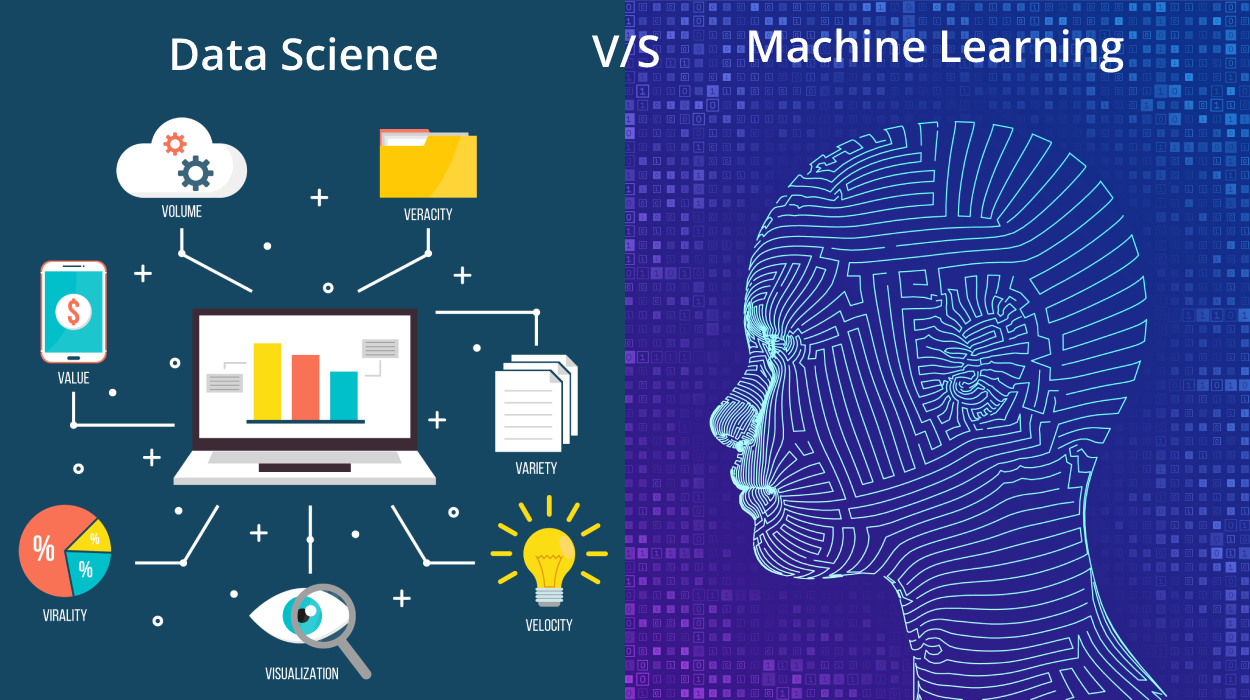In the era of big data and advanced analytics, the terms "data science" and "machine learning" have gained immense popularity. Although these concepts are closely related, they are not interchangeable. Understanding the distinction between them is essential for professionals leveraging data-driven insights and decision-making. In this article, we will explore the differences between data science and machine learning, and help you determine which approach best suits your specific needs.
Data Science: An Overview
Data science is a multidisciplinary field that involves the extraction of meaningful insights from large, complex datasets. It combines statistics, programming, and domain expertise to identify patterns and trends, enabling organizations to make informed decisions. Data science encompasses a wide range of techniques and tools, including data mining, data visualization, and predictive analytics.
Key Components of Data Science:
Data Collection: Data scientists gather data from multiple sources, such as databases, web scraping, and APIs. This process requires proficiency in programming languages like Python and R and knowledge of data extraction and cleaning techniques.
Data Analysis: Data scientists use statistical methods, including descriptive and inferential statistics, to analyze the data and draw conclusions. They must be proficient in tools like Excel, R, and Python to perform these analyses.
Data Visualization: Data visualization is crucial for communicating complex patterns and relationships in an easily understandable format. Data scientists use tools like Tableau, ggplot2, and D3.js to create visually appealing and informative graphics.
Predictive Modeling: Data scientists employ machine learning algorithms to build predictive models to forecast future outcomes. These models can help organizations make better decisions by predicting customer behavior, market trends, and more.
Machine Learning: An Overview
Machine Learning, a subfield of artificial intelligence, centres on creating algorithms and models capable of learning from data autonomously, without the need for explicit programming. In other words, machine learning systems automatically improve their performance as they are exposed to more data. Machine learning has applications in numerous industries, from healthcare to finance, and it plays a critical role in data science by enabling the development of predictive models.
Key Components of Machine Learning:
Supervised Learning: Supervised learning is the most common form of machine learning, where an algorithm learns from a labelled dataset. The algorithm is trained to predict the output based on the input features, improving its predictions as it processes more data.
Unsupervised Learning: The algorithm is not provided with labelled data in unsupervised learning. Instead, it uncovers patterns and relationships within the data itself. Examples of unsupervised learning techniques include clustering and dimensionality reduction.
Reinforcement Learning: Reinforcement learning involves training an algorithm to decide based on rewards and penalties. The algorithm learns to optimize its actions to maximize the cumulative reward over time.
Deep Learning: Deep learning is a subset of machine learning focusing on artificial neural networks. These networks, inspired by the human brain, consist of interconnected layers of nodes that hierarchically process information. Deep learning has been particularly successful in image recognition and natural language processing tasks.
Data Science vs. Machine Learning: The Key Differences
Scope: Data science is a broader field that encompasses machine learning. While machine learning is an essential tool for data scientists, data science also involves data collection, cleaning, and visualization. Machine learning, on the other hand, is primarily concerned with the development and refinement of algorithms that can learn from data.
Objective: Data science aims to extract valuable insights from data to support decision-making, while machine learning focuses on creating algorithms that can learn and improve from experience. In other words, data science uses machine-learning techniques to build predictive models and make informed decisions, whereas machine learning emphasizes the development of self-learning algorithms.
Skill Set: Data scientists need a diverse skill set, including programming, statistical analysis, data visualization, and domain knowledge. However, machine learning engineers primarily focus on developing and implementing machine learning algorithms, requiring expertise in programming languages, such as Python or R, and an understanding of various machine learning techniques.
Application: Data science is applied to various industries and domains, from marketing and finance to healthcare and sports. Machine learning also has numerous applications, but its primary purpose is to develop and refine learning algorithms that can be used to build models for various tasks, such as image identification, linguistic comprehension, and personalized suggestion engines.
Choosing Between Data Science and Machine Learning
The choice between data science and machine learning largely depends on your organization's specific needs and goals. Here are some factors to consider when deciding between the two:
Problem Definition: Clearly define the problem you want to solve. Data science is the better choice if the problem requires extracting insights from data to support decision-making. Machine learning may be more appropriate if the problem involves creating algorithms that can learn and adapt without human intervention.
Data Availability: Data science projects typically require large, clean datasets to yield meaningful results. Machine learning, on the other hand, can work with smaller, noisier datasets, as the algorithms can learn and improve over time.
Technical Expertise: Data science projects often require a multidisciplinary team with programming, statistics, and domain knowledge expertise. In contrast, machine learning projects may only require engineers with strong programming skills and knowledge of various learning techniques.
Desired Outcomes: Determine the desired outcomes of your project. If you want to make data-driven decisions or predictions, data science is the right choice. Machine learning is the better option if you aim to develop algorithms that can learn from data and improve over time.
Data science and machine learning are closely related but distinct disciplines, each with its own set of techniques, applications, and objectives. Data science focuses on extracting valuable insights from data to support decision-making, while machine learning emphasizes the development of self-learning algorithms. By understanding the differences between these fields and considering your organization's specific needs, you can decide which approach to adopt for your data-driven projects.








